Cosmic nebulae. Planetary nebulae
The emission line nebula and emission nebula create their own glow. Hydrogen atoms come into activity because of the powerful ultraviolet light from stars. The hydrogen then ionizes (loses an electron, emitting a photon).
O-type stars can ionize gas within a radius of 350 light years. The M17 nebula was discovered by de Chaizeau in 1746, and in 1764 it was rediscovered by Charles Messier. It is located in Sagittarius and is also called the Swan, Omega, Horseshoe and Lobster nebulae. Incredibly bright and its pink glow can be seen without the use of technology at low latitudes (visible magnitude 6). Inside are young stars that create the HII region. Ionized hydrogen is responsible for the red color.
Infrared light helps detect huge amounts of dust, hinting at active star formation. Inside is a cluster of 30 stars, obscured by a nebula extending across 40 light-years in diameter. The total mass is 800 times greater than the sun.
M17 is 5500 light years away. Together with M16 it is located in one spiral arm Milky Way(Sagittarius-Carinae).
Planetary nebulae are created by dying stars. By astronomical standards, planetary nebulae are very short-lived phenomena: their lifespan is about ten thousand years. Therefore, astronomers know no more than one and a half thousand similar objects in our galaxy.
The silent cosmic flame of a dying star: planetary nebula NGC 6302
The magnificent planetary Helix Nebula is one of the brightest and most beautiful.
The Cat's Eye Nebula, NGC 6543: fantastic sculptures of gas and dust photographed by the Hubble telescope.
Another false-color photo of NGC 6543. The Cat's Eye Nebula is about 1000 years old. Its shape may indicate that it was formed from a binary star system.
The famous planetary nebula M57 in the constellation Lyra, or the Ring Nebula. Images like this reveal the complex structure of the nebula.
Another famous example of a planetary nebula is MyCn18, an hourglass around a dying star.
The Medusa Nebula is a very old planetary nebula. It is located approximately 1500 light years from Earth in the constellation Gemini
The nebula NGC 3132 is a lake of light.
The planetary nebula Abell 39 has an almost perfectly spherical shape. Its diameter is almost 5 light years, and the thickness of its walls is a third of a light year. The Abell 39 nebula is located 7,000 light-years from Earth in the constellation Hercules.
When dying, a star sheds its outer layers, which, dissipating in space, form a planetary nebula. Such nebulae are called planetary solely because in small telescopes they look like tiny and dim disks. Previously, many astronomers mistook them for distant planets, which is where the name came from. But large and modern instruments show astronomers many interesting things. NGC 6369 is another example of a magnificent planetary nebula with rich structure
The planetary Dumbbell Nebula in the constellation Vulpecula is one of the brightest objects of its kind. The nebula was first discovered by the French astronomer Charles Messier, who included it in his catalog of nebulous objects under number 27. The distance to M27 is only known approximately and is about 1200 light years.
Planetary nebula NGC 2346
One of the latest photographs of the space telescope. Hubble's Necklace Nebula.
The Eskimo Nebula or NGC 2392
Spirograph Nebula
The Jones Nebula, also known as PK 104-29.1, is a very faint ghost-like nebula in the constellation Pegasus. This image was taken in 2009 by the Mayall telescope.
Planetary Turtle Nebula
The Electric Ray Nebula, or Hen-1357, is the youngest known planetary nebula.
When observing the sky through a telescope, you can sometimes stumble upon curious nebulae with rounded outlines. These are planetary nebulae - objects corresponding to the final phase of the existence of stars like the Sun. In fact, each of them is a spherical shell of gas, the outer layer of the star, ejected by it after losing its own stability. These shells then enlarge, expand and gradually become weaker. Observing such nebulae is not easy: most of them have low surface brightness and small angular size. As with other nebulae, dark, moonless nights are required for observation. Very rarely, the identification of a planetary nebula can be helped by a small star located in its center and which gave it its origin.
Ring Nebula
Of all the planetary nebulae visible in the sky, the most famous among astronomy enthusiasts is certainly the M57 nebula, which also has the name Ring Nebula. It is located in the summer constellation Lyra at a distance of about 2300 light years from Earth.
This nebula was discovered in 1779 by the French astronomer Antoine Darquier de Pellepois. He described it as a perfect disk approximately the size of Jupiter, but with a faint glow and similar to a disappearing planet. Subsequently, in 1785, the English astronomer William Herschel defined it as a “celestial landmark.” He thought that this nebula was a ring of stars.
With a hole
In your telescope, M57 will appear as a small, round, nebulous speck. It makes sense to view it at medium magnification, for example through a 12.5 mm Plössl eyepiece, which provides 80x magnification. At first glance you will notice rounded outlines. After a few minutes of adaptation, if the air is clear and still and there is no interference from the Moon, you will be able to make out some details. By increasing the magnification, you will even be able to discern the central “hole,” especially if you look with “diffused vision,” that is, concentrating your gaze not on the “hole” itself, but on its periphery.
Central star
This nebula was born from the star at its center, which today has become a white dwarf. The surface temperature of this star exceeds 100,000 degrees. Its magnitude is 14.7, making it inaccessible to your telescope. It was discovered in 1800 by the German philosopher and astronomer Friedrich von Hahn.
The nebula is expanding at a speed of approximately 20-30 km/s, and therefore its apparent size is increasing by approximately 1 arcsecond per century.
Nebula formation
After the first planetary nebulae were discovered, their rounded outlines led astronomers to believe that these celestial objects were associated with something similar to planets, most likely gas giants or an emerging planetary system. For this reason, the English astronomer William Herschel (who had recently discovered the planet Uranus) proposed the term “planetary nebula” for such objects. Their true nature was established only in the middle of the 19th century thanks to spectroscopy (a technique that allows you to “split” the light coming from celestial body, to its primary colors). Then it became clear that before us was a special type of nebula.
Dying Star
All planetary nebulae originate from stars in the final stages of their existence. As we have already noted, a star with a mass comparable to the mass of the Sun, after its birth, goes through a long stage of stability, during which it melts hydrogen nuclei, giving rise to helium nuclei. When the hydrogen contained in the central part of the star runs out, this part heats up and reaches a temperature of 100 million degrees. As a result, the outer layers expand and then cool: the star turns into a red giant. At this point, it loses stability and its outer layers can be thrown out. It is they who form a spherical shell around what remains of the star - around the white dwarf.
Extension
The shell surrounding the star expands at a speed of several tens of kilometers per second and forms a planetary nebula with a characteristic spherical shape. Planetary nebulae, however, face a fairly quick end: as they expand in space, they become rarer and, as a result, become indistinguishable in the firmament. This takes about 25,000 years - a very short period in the life of any star.
Planetary nebulae through a telescope
When observing planetary nebulae, difficulties arise somewhat different than when observing diffuse nebulae, such as the Orion Nebula. Planetary nebulae do not have large angular sizes. With the exception of the Helix Nebula, they appear small and concentrated in the sky. Therefore, they can be difficult to distinguish from stars.
Helix Nebula
In addition to M57, you can observe about a dozen other planetary nebulae with your telescope. The first among them will be the Helix Nebula from the constellation Aquarius. It reaches an impressive size - approximately 13 minutes of arc (which corresponds to a real size of about 3 light years).
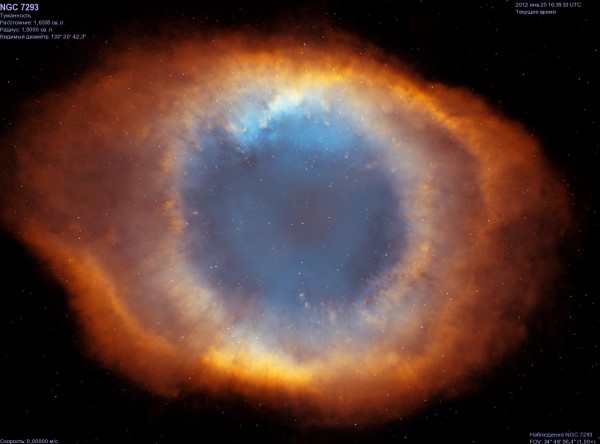
It is no coincidence that this nebula is also one of the closest to solar system. Despite its magnitude of 7.6, due to its size it spreads its glow over a very wide area of the night sky. Through a telescope, this nebula appears greenish. It is visible rather faintly. Inside it, the Hubble Space Telescope saw thousands of gas balls, apparently formed at the moment when the dying star ejected its outer shell into space.
Saturn Nebula
In the same zodiac constellation Aquarius, the nebula NCG 7009, known as the Saturn Nebula, is of interest for observation. William Herschel discovered it in 1782. The main difficulty in observing this nebula is its size, which is less than 2 arc minutes.
![]()
Nevertheless, at 50x magnification you can understand that this is not a star, and at 100-150x you can discern a characteristic elongated shape. It is for this shape that the nebula received its name, coinciding with the name of the planet with rings.
Another nebula easily accessible for observation is M27 from the constellation Vulpecula. It is also called the “Dumbbell Nebula.” Its apparent diameter is approximately 8 arc minutes and its total magnitude is 7.4. According to astronomers, this nebula formed 3000-4000 years ago. At high magnification you can see her elongated
the form for which she got her name.
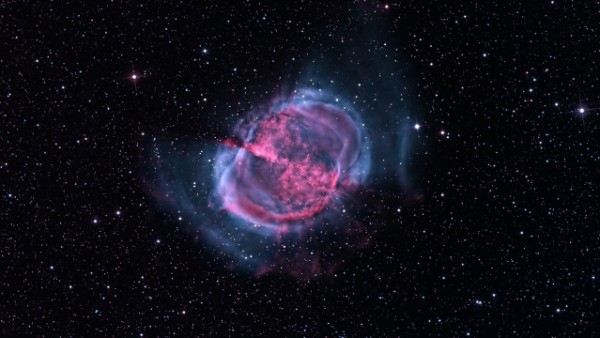
There is also a smaller version of M27, at least according to Anglo-Saxon astronomers, who call the planetary nebula M76 the Little Dumbbell. It was discovered by Méchain in 1780, but its membership as a planetary nebula was recognized only in 1918. The 16.6 magnitude star at the center of M76 is too faint for your telescope.
Ghost and Owl
Much more difficult to observe is the nebula NGC3242, which also has the curious name Ghost of Jupiter. This is explained by the fact that in a telescope its diameter is comparable to the diameter of Jupiter. With a 25 mm Plössl eyepiece at 40x magnification you can see it without much difficulty, and at a magnification of over 100 you can even discern its round shape.
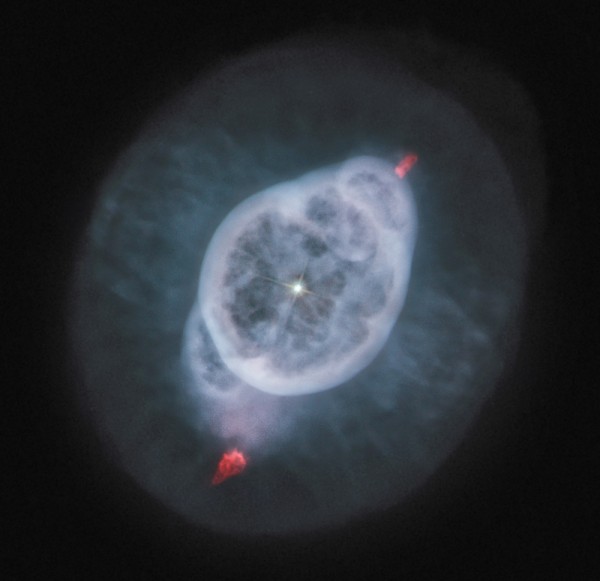
Nebula M97, the fourth nebula included in the Messier catalog, also has a funny name. It is located in the constellation Ursa Major. Irish astronomer William Warsons named it the Owl in 1848 because the two dark spots inside it resemble an owl's eyes.

At a magnification of just over 100, you will be able to discern not only the round shape of the nebula, but also two dark areas within it. M97 is believed to be approximately 8,000 years old.
Snowball
It is quite difficult to distinguish the nebula NGl 7662, or the Blue Snowball, in the sky in the constellation Andromeda. In fact, despite its name, it has a reddish tint in a telescope.

At a magnification of over 100, you can also see the “hole” in its center. The advantage of viewing this nebula is that it is located in a constellation that rises very high in our sky in late autumn.
White dwarfs
The planetary nebula NGC 1514, discovered by William Herschel in 1790 in the constellation Taurus, is very difficult to observe because it glows faintly and is barely visible against the celestial background. Much easier to spot is the white dwarf at its center, magnitude 9.4 NGC 1514 can be found about 8 degrees northeast of the Pleiades. Another planetary nebula with a white dwarf visible to your telescope is NGC6826, located in the constellation Cygnus. This is a small and faint nebula: in a telescope it will appear as a blurry star, and only by increasing the magnification to maximum will you be able to see its circular shell. However, if the sky is very dark, then you may notice a star of magnitude 10.4 in its center.
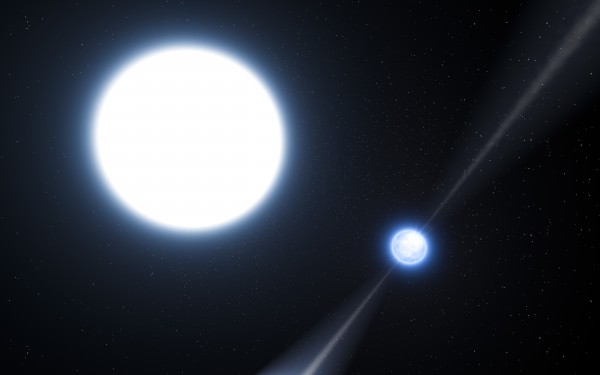
The same can be said about the planetary nebula NGC2392, also known as the Eskimo Nebula, in the constellation Gemini. A white dwarf of magnitude 10.5 will be visible inside the small, faint bluish nebula.
Planetary nebulae as seen by Hubble
Many planetary nebulae, unfortunately, remain inaccessible to observation with an amateur telescope. Although we are often talking about magnificent, very spectacular objects, some of the most beautiful in the sky. The Hubble Space Telescope has photographed some of these nebulae, allowing us to appreciate their brilliant colors and curious shapes.
Even though you won't be able to observe them with your telescope, it is worth talking about the most spectacular and interesting planetary nebulae.
Cat's Eye
You can start from the Cat's Eye Nebula (NGC 6543) in the constellation Draco. In 1864, William Hoggins examined its light with a spectroscope (the planetary nebula was then subjected to such analysis for the first time). Although it was discovered back in 1786, only recently the Hubble telescope revealed its complex and delicate structure, consisting of concentric gas shells, streams and nodules. Astronomers have concluded that approximately every 1,500 years, the central star emits a new shell. The images, taken about 10 years apart, showed that the nebula was expanding.
![]()
The nebula NGC 6369 is located in the constellation Ophiuchus at a distance of 2000 to 5000 light years. Its blue-green ring, which measures approximately 1 light-year in diameter, marks the edge of the region where the star's ultraviolet light has ionized the gas, that is, stripped electrons from its atoms. The outer part of the nebula has a more pronounced red tint because the ionization process is less intense at a greater distance from the star. The cloud is expanding at a speed of approximately 20 km/s. Due to this, it will disperse into interstellar space and then disappear after about 10,000 years.
Rectangle
The shape of the lC4406 nebula in the constellation Wolf is also very curious: it seems not round, but rectangular. Perhaps it is actually cylindrical in shape, and from Earth we only see one side of it. The nebula's fine texture (composed of dark dust) and shape, reminiscent of the membrane of the human eye, earned it the name Retina. In Hubble photographs, it appears blue where oxygen is present, green where hydrogen is present, and red where nitrogen is present.

The nebula lC418, or Spirograph, in the constellation Hare has an almost perfectly round shape. The origin of its name is easy to understand if you compare the shape of the nebula with the drawings created by this graphic tool. Its actual diameter is approximately 0.1 light-years, and its distance from Earth is about 3,600 light-years. This short tour of objects captured by the Hubble Telescope ends with Hen 3-1357, the youngest known planetary nebula. It is located in the constellation Altar at a distance of 18,000 light years from us. It is also called Stingray - it resembles a flat fish of the same name with large wing-shaped fins. Two stars are visible inside it: in addition to the central white dwarf, there is also a satellite star of a weaker glow, located above and to the left of the first. What a pity that this amazing picture can only be seen thanks to a space telescope!
Previously, the definition of “nebula” meant any static phenomenon in space that has an extended shape. Then this concept was specified by studying the mysterious object in more detail. Let's try to figure out what such a section of the interstellar medium is like.
Nebula concept in space

A nebula is a gas cloud containing a huge number of stars inside. The radiance of these celestial bodies allows the cloud to glow in different colors. Through special telescopes, such cosmic formations look like peculiar spots with a bright base.
Some interstellar regions have fairly clear contours. Many known gas accumulations are wisps of fog that spread in different directions in jets and have a diffuse form of origin.
The space that lies between the stars of the nebula is not empty substance. Particles of a diverse nature are concentrated here in fairly small quantities, which include atoms of some substances.
They distinguish between the origin of diffuse and planetary formations in space. The nature of their formation differs significantly from one another, so it is necessary to carefully understand the structure of the formation of different nebulae. Planetary objects are the product of the activity of the main stars, and diffuse ones represent the consistency after the formation of stars.
Nebulae of diffuse origin are located in the spiral arms of galaxies. Such a cosmic connection of gas and dust is in most cases associated with large and cold clouds. Stars form in this region, making the diffuse nebula very bright.
Education of this kind does not have its own source of nutrition. It exists energetically due to the stars of elevated temperature that are located next to it or inside it. The color of such nebulae is predominantly red. This factor is due to the fact that a large amount of hydrogen is present inside them. Shades of green and blue indicate the presence of nitrogen, helium and some heavy metals.
In the stellar region of Orion, very small nebulae of diffuse formation can be observed. These formations are very small against the background of a giant cloud, which occupies almost the entire described object. In the constellation Taurus, it is realistic to detect only a few nebulae near fairly young T-type stars. This variety indicates that there is a disk that appears around bright celestial bodies.
A planetary nebula in space is a shell, the energy of which is shed at the final stage of formation by a star without hydrogen reserves in the core. After such changes, the celestial body turns into a red giant, capable of tearing off its surface layer. As a result of the incident, the interior of the object sometimes has a temperature exceeding 100 degrees Celsius. As a result, the star is deformed in such a way that it becomes a white dwarf without a source of energy and heat.
In the 20s of the last century, there was a demarcation between the definitions of “nebula” and “galaxy”. The division that occurred is examined using the example of formation in the Andromeda region, which is a vast galaxy of a trillion stars.
Main types of nebulae
Space education is classified according to various parameters. The following types of nebulae are distinguished: reflection nebulae, dark nebulae, emission nebulae, planetary gas clusters and the residual product after the activity of supernovae. The division also concerns the composition of nebulae: there is gas and dust cosmic matter. First of all, attention is paid to the ability of such objects to absorb or scatter light.
Dark Nebula

Dark nebulae are fairly dense compounds of interstellar gas and dust, the structure of which is opaque due to the influence of dust. Clusters of this kind can occasionally be observed against the background of the Milky Way.
The study of such objects depends on the AV indicator. If the data is quite high, then experiments are carried out exclusively using submillimeter and radio wave astronomy technologies.
An example of such a formation is the Horsehead, formed in the constellation Orion.
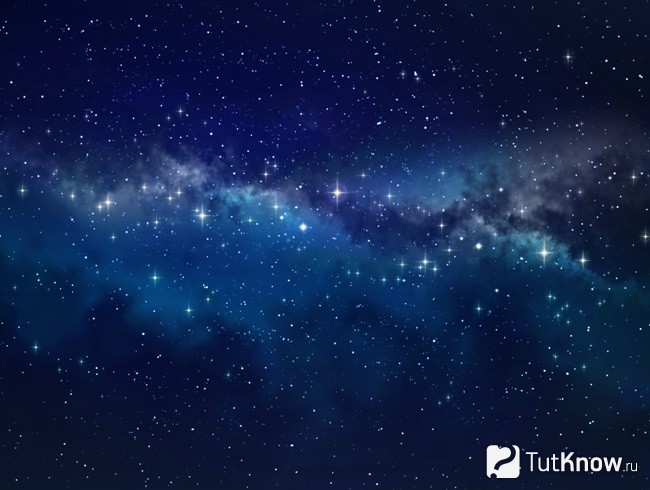
Such concentrations scatter the light carried by nearby stars. This object is not a source of radiation, but only reflects radiance.
A gas-dust cloud of this type depends on the location of the stars. At close range, there is a loss of interstellar hydrogen, which leads to a gain of energy from scattered galactic dust. The Pleiades cluster is the best example of the described cosmic phenomenon. In most cases, such gas and dust clumps are located near the Milky Way.
Light nebulae have the following subtypes:
- Cometary. A variable star underlies this formation. It illuminates the described region of the interstellar medium, but has a varying brightness. The sizes of the objects amount to hundreds of fractions of a parsec, which indicates the possibility of a detailed study of such concentrations of gas and dust in space.
- Light echo. This phenomenon is quite rare and has been studied since the beginning of the last century. The constellation Perseus after the supernova explosion in 2001 made it possible to observe a similar change in the cosmic sphere. High-intensity flares activated dust, which formed a moderate nebula over several years.
- Reflective substance with a fibrous structure. Hundreds or thousands of fractions of a parsec are the dimensions of this variety. The forces of the magnetic field of a star cluster are pushed apart under external pressure, after which gas-dust objects are introduced into these fields and a kind of shell filament is formed.
Gas nebula

Similar manifestations space activities have different shapes, and their types can be indicated by the following points:
- Planetary substances in the form of a ring. In this case, such a type of nebula is observed as a planetary one. The arrangement of its components is very simple: the main star is visible in the center, around which all external changes occur.
- Fibers of gas that release their energy separately. These luminous gaseous substances are formed in the most unexpected way in the form of scattered sparkling weaves of gas.
- Crab Nebula. It is a residual phenomenon after the explosion of a star of a new format. Such an event was recorded during the study of celestial bodies that reflect their energy. At the very center of the cluster there is a pulsating neutron star, which by some indicators is one of the most productive sources of galactic energy.
Dust nebula
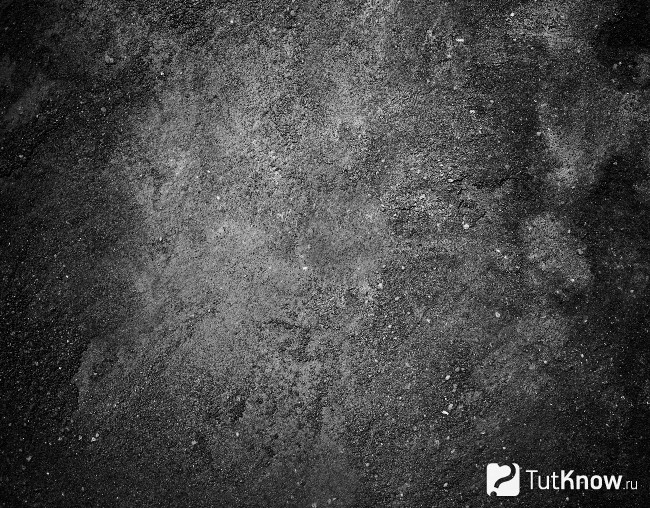
This type of nebula looks like a kind of failure, standing out against the background of a bright cosmic clump. This fragment can be observed in the constellation Orion, where a similar trail divides a single cloud into two distinct zones. Against the background of the Milky Way, there are also dusty areas that are clearly expressed in the Ophiuchus region (the Serpent Nebula).
It is possible to study such dust accumulation only with the help of a telescope of fairly high power (diameter from 150 mm). If a dust nebula is located near a bright star, then it begins to reflect the light of this celestial body and becomes a visible phenomenon. Only in special photographs will it be possible to see this ability, which is close to diffuse nebulae.
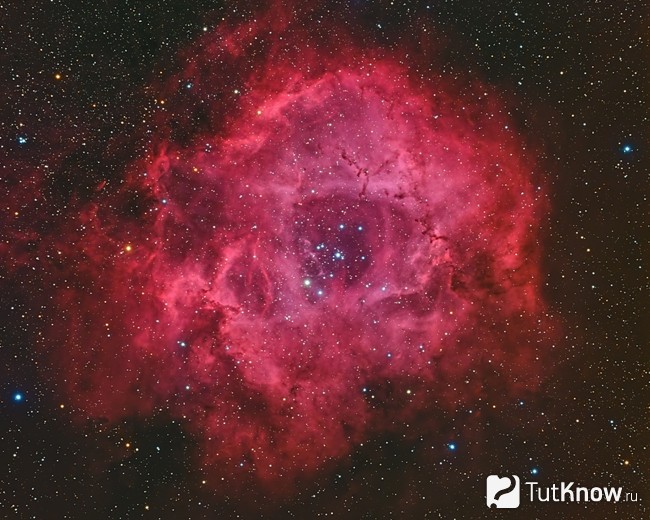
The main indicator of such a cosmic cloud is its high temperature. It consists of ionized gas, which is formed as a result of the activity of the closest hot star. Its effect is that it activates and illuminates the atoms of the nebula using ultraviolet radiation.
The phenomenon is interesting because, according to the principle of formation and visual indicators, it resembles neon light. As a rule, emission-type objects have a red color due to the large accumulation of hydrogen in their composition. There may be additional tones in the form of green and blue, which were formed due to atoms of other substances. The most striking example of such a star cluster is the famous Orion Nebula.
The most famous nebulae
The most popular nebulae in terms of study are the Orion Nebula, the Triple Nebula, the Ring Nebula and the Dumbbell Nebula.
Orion Nebula
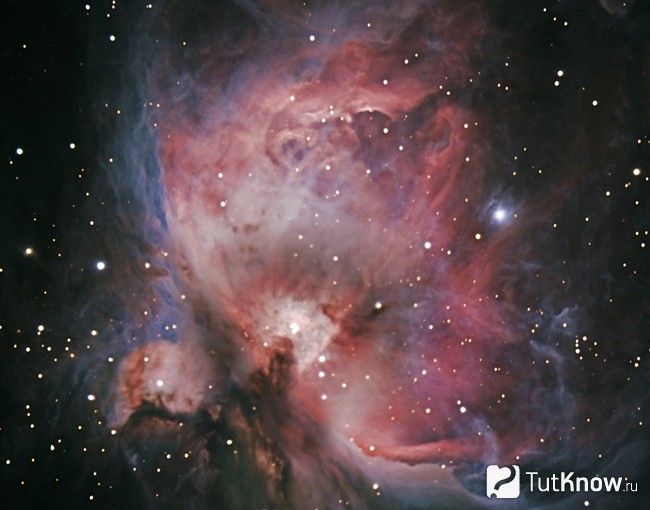
This phenomenon is remarkable in that it can be observed even with the naked eye. The Orion Nebula is classified as an emission-type formation, which is located below the belt part of Orion.
The area of the cloud is impressive because it is almost four times the size of the Moon at full phase. In the northeastern part there is a dark dust cluster, which is cataloged as M43.
In the cloud itself there are almost seven hundred stars, which are this moment are still being formed. The diffuse nature of the Orion Nebula formation makes the object very bright and colorful. Red zones indicate the presence of hot hydrogen, while blue zones indicate the presence of dust, reflecting the glow of bluish hot stars.
M42 is the closest place to Earth where stars form. Such a cradle of celestial objects is located at a distance of one and a half thousand light years from our planet and delights outside observers.
Trifid Nebula
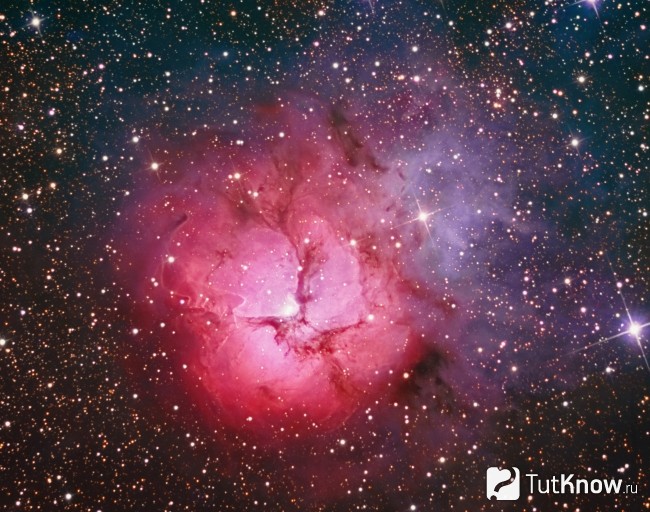
The Triple Nebula is located in the constellation Sagittarius and looks like three separated petals. It is difficult to accurately calculate the distance from Earth to the cloud, but scientists are guided by parameters of two to nine thousand light years.
The uniqueness of this formation lies in the fact that it is represented by three types of nebulae at once: dark, light and emission.
M20 is a cradle for the development of young stars. Such large celestial bodies are predominantly blue in color, which was formed due to the ionization of gas accumulated in that area. When observing with a telescope, two things immediately catch your eye: bright stars right in the center of the nebula.
Upon closer examination, it becomes clear that the object seems to be torn into two parts by a black hole. Then, above this gap, you can see a crossbar that gives the nebula the shape of three petals.
Ring
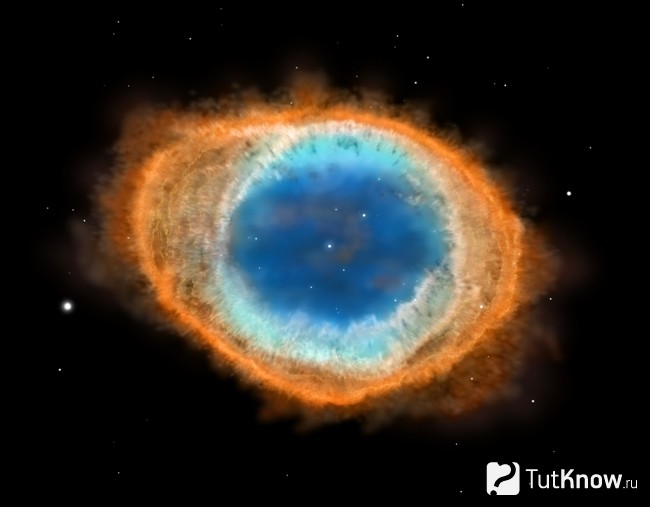
The ring, located in the constellation Lyra, is one of the most famous planetary substances. It is located at a distance of two thousand light years from our planet and is considered a fairly recognizable cosmic cloud.
The Ring glows due to the white dwarf present nearby, and the gases included in its composition act as remnants of the ejected consistency of the central star. The inner part of the cloud flickers greenish, which is explained by the presence of emission lines in that area. They were formed after double ionization of oxygen, which led to the formation of a similar shade.
The central star was originally a red giant but later became a white dwarf. It can only be viewed through powerful telescopes, because its dimensions are extremely small. Thanks to the activity of this celestial body, the Ring Nebula arose, which in the form of a slightly elongated circle envelops the central source of energy.
The ring is one of the most popular observation objects among both scientists and ordinary space enthusiasts. This interest is due to the excellent visibility of the cloud at any time of the year and even in urban lighting conditions.
Dumbbell

This cloud is the territory between stars of planetary origin, which is located in the constellation Chanterelle. Dumbbell is located at a distance of about 1200 light years from Earth and is considered a very popular object for amateur study.
Even with the help of binoculars, the formation can be easily recognized if you focus on the constellation Sagittarius in the northern hemisphere of the starry sky.
The shape of M27 is very unusual and looks like a dumbbell, which is why the cloud got its name. It is sometimes called the “stub” because the nebula’s outline resembles a bitten apple. Several stars shine through the gaseous structure of the Dumbbell, and when using a powerful telescope, small “ears” can be seen in the bright part of the object.
The study of the nebula in the constellation Vulpecula has not yet been completed and suggests many discoveries in this direction.
There is a rather bold hypothesis that gas-dust nebulae can influence human consciousness. Pavel Globa believes that such education can completely change the lives of some people. According to experts in the field of astrology, nebulae have a destructive effect on the senses and change the consciousness of the inhabitants of the Earth. Star clusters, according to this version, are capable of controlling the duration of human existence, shortening life cycle or making it longer. It is believed that nebulae have a greater influence on people than stars. Famous astrologers explain all this by saying that there is a certain program for which a certain cosmic cloud is responsible. Its mechanism begins to act instantly, and a person is not able to influence it.
What the nebula looks like - look at the video:
Nebulae are a magnificent phenomenon of extraterrestrial origin that needs to be studied in detail. But it is difficult to judge the reliability of the voiced assumption about the influence of star clusters on human consciousness!
Some of my favorite objects)). And it’s even more surprising that such beauties are not included in the album. Therefore, I’ll make up for it (especially since I promised to continue about nebulae).
What is a planetary nebula? This is a star, called the core of the nebula, and a glowing shell of gas surrounding it. Planetary nebulae were discovered by W. Herschel around 1783. The name reflects their certain similarity with the disks of the outer planets - Uranus and Neptune. There are approximately 1,500 known planetary nebulae. With the development of observation technology, it became possible to see similar objects in the Magellanic Clouds, in the Andromeda Nebula and in a number of other galaxies.
During their lives, stars continuously lose matter in the form of the so-called. stellar wind. Depending on the mass of the star and the evolutionary stage it is in, the rate of mass loss may be greater or less. Our Sun, for example, is now losing matter very slowly, this is typical for not very massive main sequence stars. However, even a weak solar wind leads to some consequences, for example, it turns out to be the cause of such a beautiful phenomenon as the aurora. In the future, the Sun will lose matter much more actively. The shedding of a red giant's shell corresponds to the loss of quite a lot of mass in the form of a slow stellar wind. It is this substance that will make up the future nebula, and the appearance of the nebula depends on its structure. However, the ejected shell itself will not shine brightly: for the birth of a planetary nebula, a collision of two winds is necessary.
The scenario for the formation of a planetary nebula is as follows. Initially, the star must lose significant mass in the form of a slow stellar wind. This could be, for example, an ejected shell of a red giant (another option is associated with evolution in a binary system). After the shell is shed, a hot core remains from the star. It becomes a source of very fast stellar wind, the flow speed is about 1000 km per second. A fast wind catches up with a powerful slow stream, and their collision makes the substance glow, as if revealing an already “woven” intricate pattern.
Will our Sun ever present such a picture? Helix Nebula- a very close example of a planetary nebula appearing at the end life path a star similar to our Sun. The gas ejected into the surrounding space by the star gives the impression that we are looking at the curl of a spiral. The stellar core remaining in the center should eventually turn into a white dwarf. The central star emits intense radiation that causes the ejected gas to glow. The Helix Nebula is located in the constellation Aquarius and is designated in the catalog as NGC 7293. This nebula is located at a distance of 650 light years from us, its dimensions are 2.5 light years. The photo montage you see is based on latest pictures the ACS (Advanced Camera for Surveys) camera on board the Hubble Space Telescope and wide-angle images of the Mosaic Camera installed on the 0.9-m telescope at the Whale Peak Observatory. A close-up view of the inner edge of the Helix Nebula reveals a complex structure of gas formations of unknown origin. 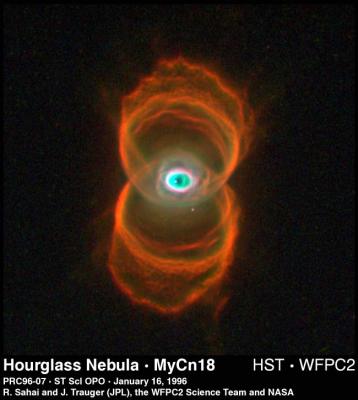
Planetary Hourglass Nebula
This is an image of the young planetary nebula MyCn18, located approximately 8 thousand light years away. years was obtained by the Wide Field Planetary Camera 2 on board the space telescope. The image was synthesized from three different images taken in the red line of ionized nitrogen, the green line of hydrogen, and the blue line of doubly ionized oxygen.
Previous images from Earth show two intersecting rings but lack detail. According to one theory, the formation of this shape is associated with a fast stellar wind inside a slowly expanding cloud, which has a density greater at the poles than at the equator. The space telescope also discovered other new unexpected properties in the structure of this nebula. For example, there are a couple of intersecting rings in the central area and numerous arcs. These features can be satisfactorily explained by the presence of an invisible companion star.
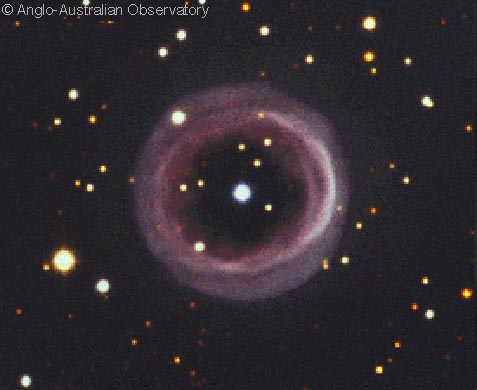
The planetary nebula pictured here is called Shapley 1 in honor of the famous astronomer Harlow Shapley, it has a pronounced ring structure.
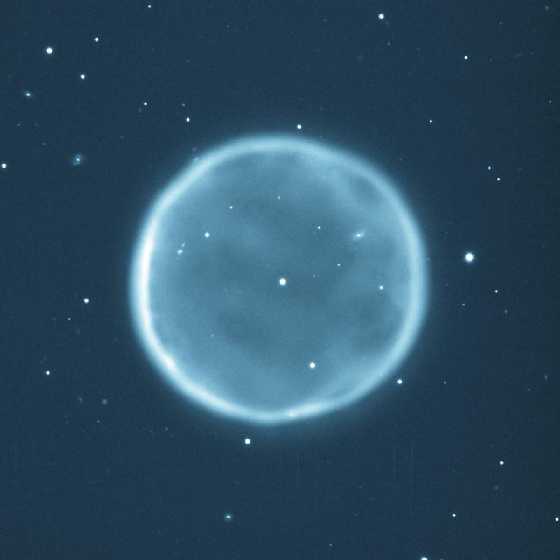
The very fact of the existence of one of the largest spheres in our Galaxy is a source of valuable information about the chemical composition of stars. Planetary nebula Abell 39, which is now six light years across, represents the outer layers of the atmosphere of a solar-type star, ejected by it several thousand years ago. The almost perfect spherical shape of Abell 39 allowed astronomers to accurately estimate the ratio of absorbing and emitting matter in it. According to observational data, the oxygen content of Abell 39 is about half that of the sun - a very interesting, although not surprising result, confirming the differences chemical composition two stars. The reason for the off-central position of the nebula's central star (it is displaced by 0.1 light years) has not yet been established. The distance to Abell 39 is about 7,000 light-years, and the galaxies visible up close and through the nebula are millions of light-years away.
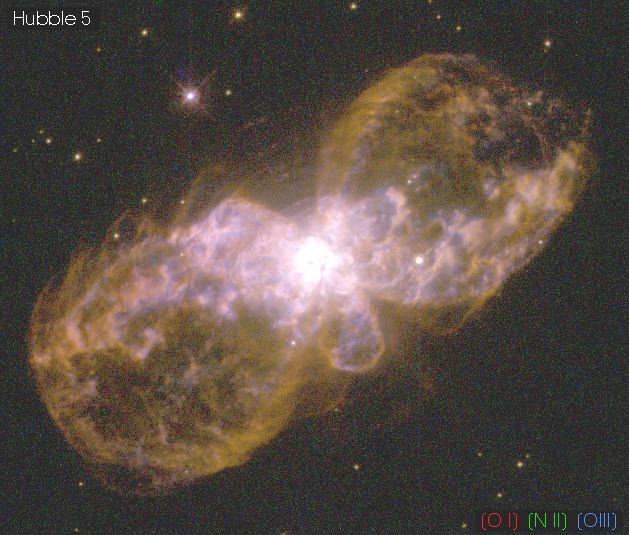
This planetary nebula with two bubbles, imaged by the Space Telescope. Hubble, it “boils” beautifully. Designated Hubble-5 this bipolar planetary nebula was formed by a hot wind of particles escaping from the central star system. The hot gas expands into the surrounding interstellar medium in the form of inflating hot gas balls. A supersonic shock wave is formed at the boundary, which excites the gas. The gas glows when electrons recombine with atoms. In the picture, the colors correspond to the energy of recombination radiation. This nebula is located 2,200 light years from Earth. At the center of the nebula there is most likely a Sun-like star that is slowly turning into a white dwarf.

Why does this “ant” look so different from a ball? After all, planetary nebula Mz3- this is the shell thrown off by a star like our Sun, that is, an object, without a doubt, spherical. Why then does the gas flowing from the star give rise to an ant-shaped nebula, the shape of which has nothing in common with a ball? The reasons for this may be the extremely high - up to 1000 kilometers per second - speed of the emitted gas; the gigantic size of the structure, reaching one light year; or the presence of a strong magnetic field in a star located above the center of the nebula. Another star of lower luminosity may also be hidden in the depths of Mz3, which orbits the bright star at a very close distance from the latter. According to another hypothesis, gas flows owe their direction to the rotation of the central star and its magnetic field. Astronomers hope that, thanks to the central star's resemblance to the Sun, studying the history of this giant cosmic ant will provide a glimpse into the future of the Sun and our Earth.

This planetary nebula is formed by a dying star that sheds its shells of glowing gas. The nebula is located at a distance of three thousand light years. In today's picture taken by the space telescope. Hubble, shows how complex the structure of the nebula is cat eye. Because of the complex structure visible in this image, astronomers believe the bright central object is a double star.

Eskimo Nebula
This planetary nebula, first discovered by Herschel in 1787, was nicknamed "Eskimo" because it resembled a face surrounded by a fur hood from ground-based telescopes. In the Hubble image, the "fur hood" appears as a disk of gas decorated with comet-like objects (see also the Helix Nebula) - elongated tails from the star.
"Face" also contains interesting details. The bright central region is nothing more than a bubble blown into space by the intense wind of fast particles from the star.
The Eskimo Nebula began to form about 10,000 years ago. It consists of two elongated bubbles of material flowing into opposite directions. In the picture, one of the bubbles lies above the other, overlapping it. The origin of the comet-like features remains mysterious.
The Eskimo Nebula is located 5,000 light-years from Earth in the constellation Geminga. The colors correspond to luminous gases: nitrogen (red), hydrogen (green), oxygen (blue) and helium (purple).

This beautiful planetary nebula, cataloged as NGC 6369, was discovered by the 18th century astronomer William Herschel when he explored the constellation Ophiuchus with a telescope. Round and planet-like, this relatively faint nebula has received the popular name Nebula Little Ghost. The amazingly intricate details of NGC 6369's structure are revealed in this remarkable color image, based on data obtained by the Cosmic Mission. Hubble telescope A. The nebula's main ring is about a light year in diameter. Emission from ionized oxygen, hydrogen, and nitrogen atoms is shown in blue, green, and red, respectively. The Little Ghost Nebula, more than 2,000 light years away, reveals the future fate of our Sun, which is also about to form its own beautiful planetary nebula, but not before? than in about five billion years.

Planetary nebula IC 418, nicknamed The Spirograph Nebula for its similarity to the drawing instrument of the same name, it is distinguished by a very unusual structure, the origin of which still remains largely unsolved. The nebula may owe its bizarre shape to the chaotic wind emanating from the central variable star, the brightness of which changes unpredictably over time intervals of just a few hours. Moreover, according to available data, just a few million years ago, IC 418 was apparently a simple star similar to our Sun. Just a few thousand years ago, IC 418 was an ordinary red giant. However, after exhausting its nuclear fuel reserves, the outer shell of the star began to expand, leaving behind a hot core, which fate destined to turn into the white dwarf star located in the center of the image. Radiation central core excites atoms in the nebula, causing them to glow. IC 418 is located about 2000 light years away from us, and its diameter is 0.3 light years. This false-color image taken recently by the Hubble Space Telescope shows unusual details in the nebula's structure.
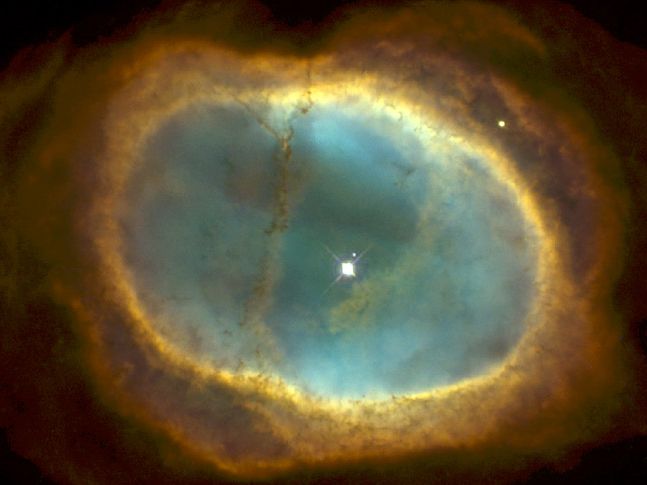
In the center NGC 3132, an unusual and beautiful planetary nebula, is home to a double star. By its origin this nebula, also called Nebula of eight flashes or Southern Annular Nebula, is due not to a bright, but to a faint star. The source of the glowing gas is the outer layers of a star similar to our Sun. Energy for a hot blue glow around dual system, which you see in the figure, gives the high temperature on the surface of the faint star. The planetary nebula initially became an object of research due to its unusual symmetrical shape. She subsequently attracted attention when she was revealed to have asymmetrical details. So far, neither the strange shape of the cooler envelope nor the structure and origin of the cold dust lanes crossing the nebula NGC 3132 have been explained.
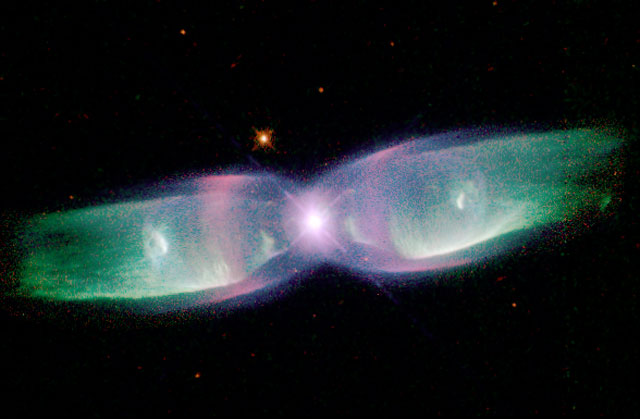
Is it true that stars look more beautiful when they die? Planetary nebula M2-9, Butterfly Nebula, is located at a distance of 2100 light years from Earth. The nebula's wings may tell us an unusual, unfinished story. At the center of the nebula is a double star system. The stars of this system move inside a gas disk 10 times the diameter of Pluto's orbit. The ejected shell of a dying star bursts out of the disk, forming bipolar structures. Much remains unclear about the physical processes that result in the formation of a planetary nebula.

How could a square nebula form around a round star? A study of a planetary nebula like IC 4406. There is reason to believe that the nebula IC 4406 has the shape of a hollow cylinder, and the square shape is explained by the fact that we are looking at this cylinder from the side. If we were to look at IC 4406 from the end, it might well look like the Ring Nebula. This color image is a combination of images taken by the Hubble Space Telescope. Hot gas flows from the ends of the cylinder, and filaments of dark dust and molecular gas line its walls. The star that is responsible for this piece of interstellar sculpture lies at the center of a planetary nebula. In a few million years, all that will remain of IC 4406 is a fading white dwarf.

Rapidly expanding clouds of gas spell the end of the nebula's central star Rotten Egg. Once there was a normal star, it used up its reserves of nuclear fuel, as a result of which its central part collapsed, forming a white dwarf. Part of the released energy causes the outer shell of the star to expand. In this case, the result is a photogenic protoplanetary nebula. When the gas, moving at millions of kilometers per hour, hits the surrounding interstellar gas, it creates a supersonic shock wave in which ionized hydrogen and nitrogen glow blue. Previously, there were hypotheses about the complex structure of the shock front, but until now such clear images had not been obtained. Thick layers of gas and dust hide the dying central star. The Rotten Egg Nebula, also known as the Pumpkin Nebula and OH231.8+4.2, is likely to develop into a bipolar planetary nebula within 1000 years. The nebula shown above is about 1.4 light years in size and located 5000 light years away in the constellation Puppis
You can show the pictures endlessly, especially since they are amazingly beautiful.
